Beans
About the ingredient beans. Including 235 recipes with beans, nutrition data, photos, and where to find it.
Contents
What are beans?
Also check out our in depth articles on Dried Beans - A low-cost and healthy addition to your diet and Hill of Beans.
Beans are the seed or seeds of many plants both trailing vines and erect bushes, which are easily cultivated.
They belong to the group of foods called legumes which also include peas, lentils, and peanuts.
Next to cereals, it is the legume family which contributes most substantially toward feeding the people of the world.
Thanks to their high protein content, beans are an absolute necessity in countries where little meat is eaten.
Broad beans were one of the oldest cultivated plants. They have been found in Bronze Age deposits in Europe (about 3000 B.C.) and we know that they were grown by the ancient Egyptians, Greeks, and Romans.
Beans played a prominent part in their rituals, as offerings of food for the dead and to the powers of the afterworld.
In China, as far back as the 1st century A.D., records show that many a merchant made a fortune on bean relishes.
The common field, garden, or kidney beans are native to the New World. Cultivated possibly by the Incas of Peru, they were used extensively by the Indians of both South and North America.
The North American Indians appreciated the fact that beans could be grown in poorer soil than corn, that they could be dried for easy storage, and that they contained a high-energy content most important in the cold winter.
When the meat supply dwindled, beans became an excellent source of protein. Knowledge of bean cultivation, learned from the Indians, was greatly appreciated by early settlers to North America.
Beans were grown as a commercial farm crop for the first time in 1836 in the eastern part of New York State. As a farm industry it was given great impetus when the government started to buy beans for the army during the Civil War.
Today the young pods (green or snap beans), the unripe seeds (shell beans), and the dried ripe seeds are all used for human consumption, while the whole plant is used for forage.
The garbanzo bean, or chick-pea, is a native of southern Europe, brought to the US by Spaniards. Lima beans came north to the US from Peru and Brazil.
The soy-bean is a most important legume in the Far East. It is the richest natural vegetable food known.
On this continent, where beans were already being grown before the first settlers arrived, they have wandered across the country with the settlers, and have long been featured in many well-known original dishes: Succotash, Boston Baked Beans, Southern Black Bean Soup, Western Chili, and Mexican Refried Beans.
Last but not least comes the magical bean. Folktales are full of magic beans; beans that spanked beans that laughed until their sides split, and love all the tales ever told about the magical beans.
Nutrition
Nutrition Facts
Serving Size 1 cup (253g)Where found
Beans are usually found in the asian section or aisle of the grocery store or supermarket.
Food group
Beans are a member of the Legumes and Legume Products US Department of Agriculture nutritional food group.
How much do beans weigh?
| Amount | Weight |
|---|---|
| 1 cup | 253 grams |
Related
Legumes and Legume Products
| In Chinese: | 豆子 | |
| British (UK) term: | ||
| en français: | haricots | |
| en español: | frijoles |
Recipes using beans
There are 235 recipes that contain this ingredient.

Elevated Tuna-Pasta Salad
This can tuna pasta salad brings canned tuna to life with a burst of fresh and hearty flavors. The combination of green beans, tomatoes, olives, capers, and pasta creates a vibrant and satisfying dish. It's a delicious way to elevate canned tuna into a memorable meal.
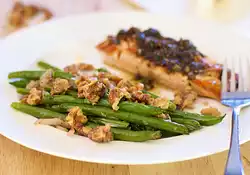
Green Beans with Walnuts & Tarragon
Lovely mingle of flavours. I toasted the walnets. Used dried tarragon but soaked in the oils w/orgainc cider vinegar in advance. Oh yeah and added 1 clove of finely minced garlic. A big hit with or without the garlic. High class side dish using the fresh beans from my local country road farmer.

Very Cheesy Casserole
Packed with healthy whole-grain and cheesy goodness. 3 cheeses, feta, cottage and parmesan cheese plus beans and brown rice. This hearty casserole is tastes great and is loaded with nutritious healthful ingredients.
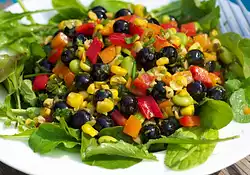
Blueberry, Roasted Corn, Soy Bean & Arugula Salad
Fresh blueberries, roasted sweet corn, soy bean, red bell pepper and peppery arugula are tossed with a white wine vinegar-olive oil vinaigrette. It's a light and tasty summer salad that accompanies well with any barbecued dishes.
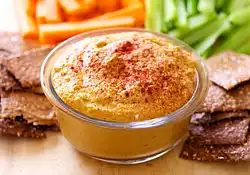
Edamame & Roasted Bell Pepper Hummus
What a tasty hummus. If you have never tried to make a hummus with edamame, roasted bell peppers, and peanut butter, you should add this one to your to-try list. Carrot, celery, chips or crackers all go deliciously well with it.

Besttexas Chili
Besttexas Chili recipe

Besttexas Chili
Besttexas Chili recipe

Tuscany White Bean Soup
A thick and delicious soup that's made with great northern beans and a variety of spices.

Carol's Favorite Vegetarian Chili
Carol's Favorite Vegetarian Chili recipe
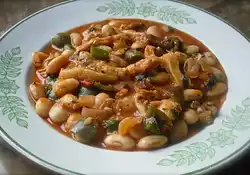
Spicy Tripe & Beans
Completely different recipe than Jamaican or Spanish ones. I used few known methods to make beans easier to digest. They all work very well not to make music.
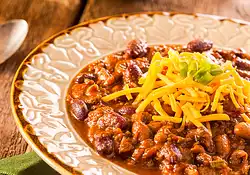
Best Texas Chili
Best Texas Chili recipe
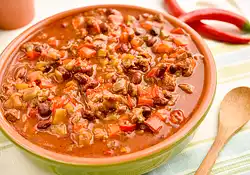
Andy Beals' Chili
About half of the beans I used were chili beans. And I used a Guinness beer. I (roughly) seeded the jalapenos and this was surprisingly still spicy. A cheap cut of beef works quite well; the beef chunks get so tender and this is an overall delicious dish. I froze half of it.

California Beef & Bean Chili
California Beef and Bean Chili recipe
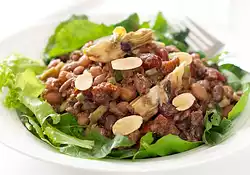
Five Bean, Artichoke & Sundried Tomato Salad with Greens & Toasted Almonds
This filling yet delicious bean salad is very easy to make. Put the salad in the frige for a couple of hours or overnight, the flavor will be even better. Of course you can always have some right after you make it to satisfy your caving before it grows too big :)

Roasted Bell Pepper & Bean Dip
This simple and tasty dip, you can serve with pita chips or any kind of fresh vegies.
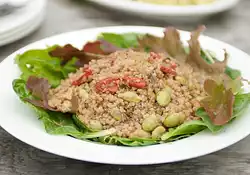
Quinoa Salad with Soy Bean, Roasted Pepper & Nuts
Toasting adds strong nutty flavor into quinoa, roasted walnuts add another layer of nutty flavor and texture. It is a very flavorful and light side dish that goes well with any main course.

Minted Edamame Roasted Tomato Canapes
Fresh soybeans (edamame) dip on crackers topped with a roasted cherry tomato. Perfect light tasting finger food when company is coming.
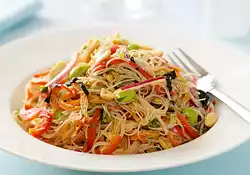
Soy Bean Salad with Brown Rice Noodles
A tasty yet light salad is made with brown rice noodles, soy beans, carrot, bell pepper, red onion, sea weed, and a sour-sweet dressing.

Chinese Quinoa & Edamame Salad
Soy sauce, sichuan hot chili oil, sesame oil, rice vinegar... These tangy Chinese seasonings make this quinoa and edamame salad taste absolutely flavorful, and it's a delicious salad that can be served as a side dish or a main dish; warm, at room temperature or chilled.
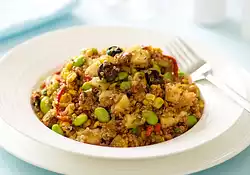
Quinoa, Edamame & Roasted Corn Salad with Apples & Maple Walnuts
This delicious and nutritious quinoa salad can be served as a side dish, or it can be a tasty yet wholesome meal all by itself.
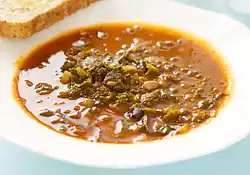
Cannellini Bean Soup with Kale & Garlic-Olive Oil Crostini
Use seasonal kale to make this hearty and delicious soup. The garlic-olive oil crostini is a must to help soak every drop of yumminess.

Curry Potato, Edamame & Lentil Soup
Packed with great flavors and textures. This curry potato, edamame and lentil soup is delicious and full of goodness. Serve it with rice or bread to soak all the yumminess.

Mixed Green Salad with Apple & Smoked Cheddar
A plateful of refreshing salad that has mixed greens, apples, and smoked cheddar tossed with a red wine vinegar and olive oil vinaigrette.

Mediterranean Bean Soup
A clean tasting soup that is packed with protein rich beans.






